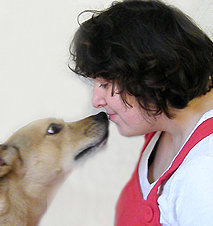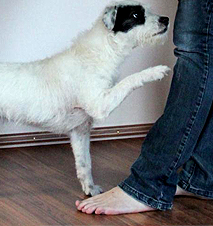Diabetes Alert Dogs
At the Assistance Dog Center T.A.R.S.Q.® we only train diabetes alert dogs who can actually alert of oncoming hypoglycemia and hyperglycemia. Alert dogs react BEFORE the hypoglycemia or hyperglycemia. occurs and alert the diabetic in good time!
Diabetes alert dogs are trained assistance dogs. They are usually trained for 18 to 24 months, are held to the same standards as, for example, an assistance dog who accompanies someone in a wheelchair, and have all the same rights as an assistance dog. Diabetes alert dogs save lives daily and prevent comas, seizures and death. A well trained diabetes alert dog can also reduce the possibility of further complications and provide a diabetic with an almost completely normal life. Diabetes alert dogs are trained for both adults and children, predominantly through owner trained dogs with the assistance of an assistance dog trainer.
The training of diabetes alert dogs began in the USA in 2003. In Germany, the training of diabetes alert dogs began in 2007, initially at the German Assistance Dog Center T.A.R.S.Q.. The founder of the Assistance Dog Center T.A.R.S.Q.®, Luca Barrett, is seen as a worldwide expert on diabetes alert dogs. Over the years she has helped numerous assistance dog organizations in Europe and abroad to establish serious diabetes alert dog programs, so that diabetics in other countries can also receive the reliable assistance of a diabetes alert dog.
Diabetes alert dogs don't immediately notify someone of reduced or increased blood sugar levels, but they react before blood sugar levels go below 70 or go above 250. Diabetes alert dogs alert of hypoglycemia while blood sugar levels are still sinking. They alert the diabetic of oncoming hypoglycemia or hyperglycemia. before it actually occurs. Good diabetes alert dogs will warn of oncoming hypoglycemia when blood sugar levels are at 120 or 148, for example, and will fall into hypoglycemia within the next few minutes. A diabetes alert dog doesn't give a warning about a blood sugar level of 120 or 148 if the level remains stable and there is no imminent threat of hypoglycemia. A diabetes alert dog won't even warn of a blood sugar level of 80 if it remains stable and doesn't decrease further. Diabetes alert dogs only give a warning if blood sugar levels are going to sink into hypoglycemia in the near future . Good diabetes alert dogs will warn of high blood sugar levels when they reach 170. A diabetic can therefore eat something with carbohydrates or inject themselves with insulin to fight either hypoglycemia or hyperglycemia.
A dog has to be born a diabetes alert dog - you can't make a diabetes alert dog!
A dog can't be taught the ability to give a warning before a life-threatening event becomes severe. Either it has the sensitivity to pick up on an oncoming event, or it doesn't. It is therefore of paramount importance to choose the right dog who possess this innate ability. Not every dog can recognize oncoming hypoglycemia and hyperglycemia.
A diabetes alert dog warns its diabetic by prodding them or laying its paw on them. The way in which a diabetes alert dog warns of oncoming hypoglycemia or hyperglycemia. is innate and doesn't require training. This natural ability is simply encouraged in training.
The biggest difficulty with training diabetes alert dogs is that only very few dogs possess this alert ability - an ability which can't be taught. Alert dogs are born with this ability. Puppies who have this ability start to notice hypoglycemia and hyperglycemia. a few minutes before they occur when they're just 3 weeks old and have just started walking.
Diabetes alert dogs have to want to notice oncoming hypoglycemia or hyperglycemia. before it happens, and to make their partner aware of it. A diabetes alert dog has to act on its own initiative and not just give a warning when commanded to. This fact illustrates the uniqueness of alert dogs, and the difficulty in finding and training them. If a diabetes alert dog doesn't want to alert a diabetic to an oncoming episode, it won't. If a dog doesn't have the ability to recognize hypoglycemia and hyperglycemia. before it occurs, it will never gain the ability. Neither trainer nor diabetic can really influence the ability to reliably give a warning prior to a hypoglycemia or hyperglycemia. This depends on several factors, such as the ability of the dog, the bond it has, and the reaction of the diabetic.
During training at the International Assistance Dog Center T.A.R.S.Q.®, a qualified assistance dog trainer will help the team to encourage reliable warnings and avoid mistakes, so that the diabetic can really rely on their diabetes alert dog. It is especially important to the International Assistance Dog Center that diabetics can rely on their dogs giving reliable warnings. Diabetes alert dogs who have all the necessary qualities, and have gone through all the training, and who warn and support their partner for the rest of their life, will give a warning for oncoming hypoglycemia and hyperglycemia. 90-100% of the time.
- A diabetes alert dog's tasks
A diabetes alert dog's main task is to notice increases and decreases in the blood sugar level, and to warn the diabetic right before hypoglycemia or hyperglycemia. occurs. If needed, a diabetes alert dog can learn to call for help with an emergency telephone in cases where the diabetic falls unconscious.
- Scientific studies on diabetes warning dogs
Scientists were already studying the phenomenon of dogs who could recognize hypoglycemia before the first diabetes alert dog was trained. In 1992, a study was published in the journal "Diabetic Medicine," in which 38% of diabetics living with a dog reported that their dog had at least once behaved differently while they were experiencing hypoglycemia. In 2000 the University of Liverpool carried out a study with three diabetics and their dogs, which revealed that the dogs reacted to hypoglycemia. In Belfast, Ireland, researchers carried out a study in 2008, in which 106 diabetics reported that their dogs were present during severe hypoglycemia. 72 of these dogs reacted at least once to severe hypoglycemia by falling unconscious.
In 2008 the German Assistance Dog Center T.A.R.S.Q. carried out a study with 104 dogs living with type 1 diabetics. The study focused on the question of how many dogs reliably gave a warning of each hypoglycemic event without having had any training. Only three dogs gave reliable warnings.
Beginning in 2008 the German Assistance Dog Center T.A.R.S.Q. carried out a further study on the effectiveness of diabetes alert dogs. The researchers compared the alerting abilities of the dogs with that of a blood sugar sensor which constantly measures blood sugar levels. In all cases, hypoglycemia was noticed reliably by the diabetes alert dogs, sometimes minutes before the blood sugar sensor alarm sounded.
In 2009 Queens University in Belfast carried out a study with 212 type 1 diabetics with dogs. 65.1% of the dogs reacted at least once to hypoglycemia. It was determined, however, that only one dog would react to hypoglycemia in households with more than one dog.
In July 2013 the study, "Can trained dogs detect a hypoglycemic scent in patients with type 1 diabetes", was carried out in the USA, and published in the Journal "Diabetes Care". The study was performed by researchers together with a diabetes alert dog organization in the USA. The organization had for many years trained dogs with odor samples to become diabetes alert dogs who could reliably help diabetics.
They used a cotton pad at the end of a wooden stick similar to a Q-tip. If a client become hypoglycemic or hyperglycemic he was to swab his skin with the cotton pad and send it to the organization to use in dog training.
The organization reported that they had trained dogs in such a way that they could reliably give warnings of hypoglycemia and hyperglycemia. The organization's fully trained diabetes alert dogs who most reliably warned the diabetics with which they lived were chosen for the study. In the study these diabetes alert dogs, who had reliably warned their owners, were presented with the odor samples of other diabetics. The goal of the study was solely to find out whether dogs react to a smell during hypoglycemia. This is why they were only presented with the samples, and did not encounter the diabetics themselves while they were in a state of hypoglycemia. Skin swabs were taken while blood sugar was at normal levels, as well as during hypoglycemia (<60), and presented to the dogs. The researchers did not know, when presenting the swabs to the dogs, which samples were hypoglycemic and which were taken when blood sugar levels were normal. The dogs had a 50/50 probability of being correct and decided incorrectly roughly half the time. The researchers concluded that dogs do not recognize hypoglycemia by smell. They inferred that dogs must notice something else when they warn of hypoglycemia. The study can be read here: http://care.diabetesjournals.org/content/36/7/e98.full.pdf
In 2014 the research team at the German Assistance Dog Center T.A.R.S.Q. succeeded in finding out what it is that dogs notice when they warn of hypoglycemia and hyperglycemia. The results show that dogs give a warning because they notice reduced oxygen saturation. The dogs don't react primarily to blood sugar levels, but to the change in oxygen saturation in the body of the diabetic, which occurs when the blood sugar becomes hypoglycemic or hyperglycemic. In a 7 year long behavioral study, the researchers found out that dogs not only react in the same way to hypoglycemia and hyperglycemia, but also to focal epileptic seizures, migraine attacks and life-threatening asthma attacks. Dogs between the ages of three weeks and seven years, with an innate ability to give warning without having had any training, took part in the study. The dogs gave a warning by prodding at the hand, ear, leg or mouth, licking the hand and mouth and laying down a paw; these warnings were identical with all of the illnesses. Dogs who warned of hypoglycemia warned of migraine attacks and focal seizures in the same way. This observation suggested that dogs notice the same thing with all these illnesses.
Between May 2013 and February 2014 the team at the German Assistance Dog Center carried out a study with 24 participants and fourteen dogs. The participants consisted of seven type 1 diabetics, one type 2 diabetic, two epileptics with focal seizures, one asthmatic and one migraine sufferer, as well as twelve healthy people, all between ten and 63 years old. All the dogs had been proven to have the innate ability to warn and showed this ability with those known to them, as well as study participants who were strangers to them. The dogs consisted of two crossbreeds, seven rough Collies, four Lollies and one Standard Poodle. Each participant was observed over several days with different dogs, with only one dog being in the room at any one time. During this time each participant wore a pulse oximeter on their finger, which constantly measured the SpO2 level of the participant. The diabetics regularly measured their blood sugar. At the beginning of the study, it was determined that each participant had a normal SpO2 level, while the blood sugar levels of the diabetics were optimal and the epileptics, migraine sufferers and asthmatics were not in any danger of an imminent attack. The dogs did not give a warning with any of the healthy participants over the whole course of the study. The healthy participants' SpO2 level also did not change. The SpO2 levels of the diabetics sank by at least three units from the normal individual levels every time their blood sugar sank to the level of oncoming hypoglycemia or rose to the level of oncoming hyperglycemia. The SpO2 levels of the epileptics decreased significantly shortly before a focal seizure. The SpO2 levels of the asthmatic and the migraine sufferer also decreased shortly before an attack. Every time the pulse oximeter showed a decrease of three to four units, the dog stood up, went to the test person and showed typical alerting behavior by prodding, licking or laying down a paw. If a diabetic delayed snacking on a carbohydrate after a warning of hypoglycemia from the dog, the SpO2 level decreased further to SpO2 91. When a slow decrease of blood sugar levels into hypoglycemia occurred, reduced oxygen saturation sometimes continued. The SpO2 level also sank further during focal seizures and life-threatening asthma attacks, after having in some cases increased for a short time before decreasing again. The SpO2 levels normalized again only when blood sugar levels were stable or the attacks were over. The dogs continued giving warning signs until the SpO2 level returned to normal. None of the dogs gave a warning if the SpO2 level did not decrease by at least three units. The researchers came to the realization that the dogs noticed a decreasing oxygen saturation, and this was responsible for the warnings the dogs gave. When oxygen saturation decreases, the breathing rate changes by an amount imperceptible to humans. The researchers conclude from this that the dogs hear small changes in breathing rate, as all alert dogs make clear ear movements to localize a noise before they go to the person and give a warning.
- Preconditions for having a diabetes alert dog
You or your child has type 1 diabetes and are no longer in the remission phase. During the remission phase the pancreas still produces some insulin, which can influence and confuse the alerting ability of a dog.
You have difficulty noticing hypoglycemia or hyperglycemia in time.
Your life is restricted by the illness and you hope to improve your quality of life with a diabetes alert dog.
The diabetic should measure their blood sugar when the dog gives a warning and also take measures, such as snacking on a carbohydrate or injecting insulin.
The diabetic is willing and capable of establishing and maintaining a connection with the diabetes alert dog.
The diabetes alert dog has to have a strong connection with the diabetic, so that it knows who it should be keeping an eye on. All other family members must restrict their interactions with the diabetes warning dog, so that they don't endanger the reliability of the dog as a warning dog.
The diabetic is with the diabetes warning dog 24 hours a day.
The diabetic always stays close to the diabetes alert dog, so that the dog can help them.
The diabetes alert dog is the only dog in the household, so that other dogs do not distract it from its work. Other animals such as cats present no problem.
If the diabetes alert dog is trained for a child, the child should want to have a diabetes alert dog, and do the extra daily work required. A diabetes alert dog should not just be brought in on the wishes of the parents. Your child should be at least six years old, although a minimum age of four is possible in special cases, and upon discussion with the assistance dog trainer in your area.










